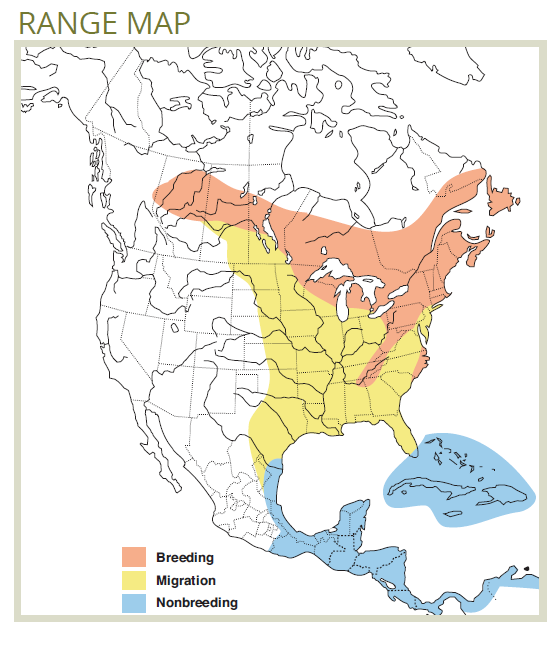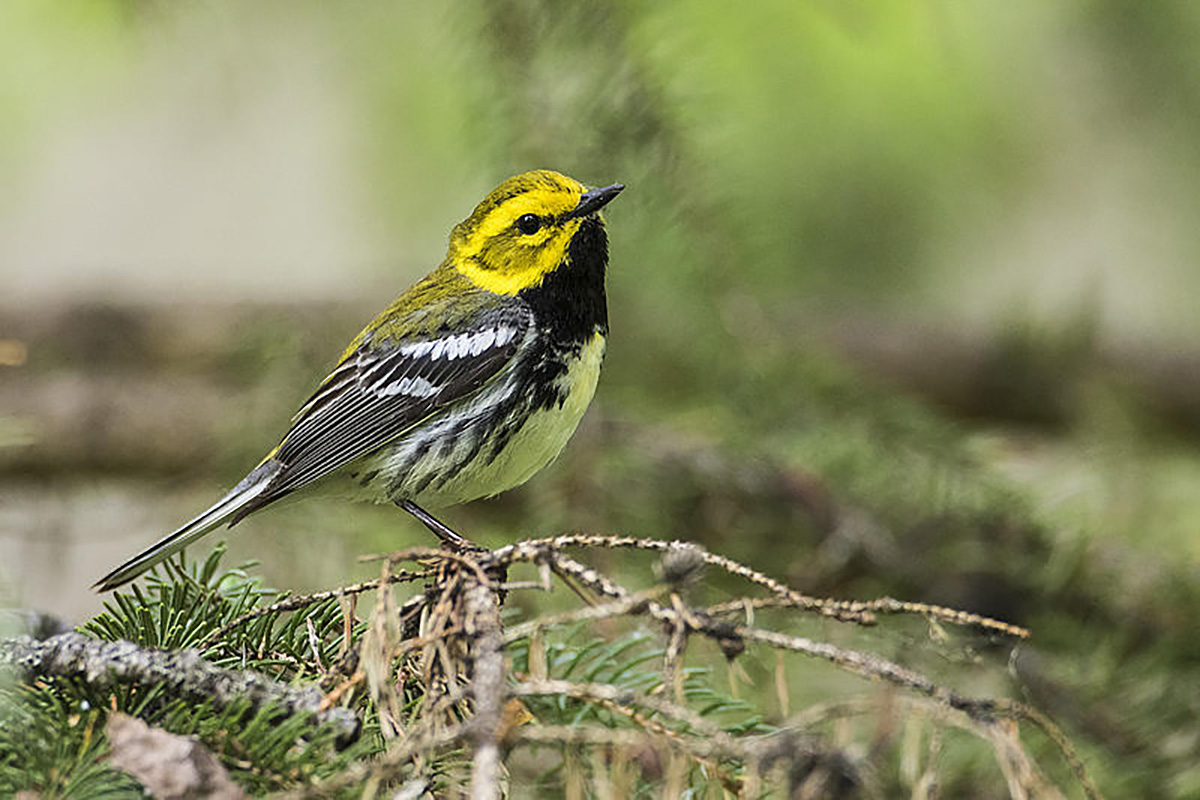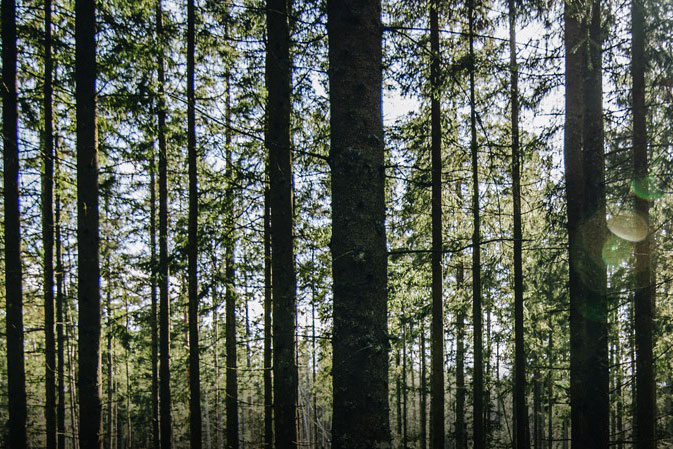A striking bird with a striking song. Listen for “see-see-see-see-see-SooZIE” in pure or mixed white spruce stands.
Black-throated Green Warbler
(Setophaga virens)
Habitat Ecology
- Black-throated Green Warblers are found in a wide range of forests containinglarge white spruce (including mixedwoods and deciduous-leading forests), with their highest densities in 100–130 year stands where they often use small-scale canopy gaps.1,2 They are also known to occupy young to mature forests.3,4
- In BC, mature riparian white spruce or mixedwood forests are considered their most important habitat, while mature or old deciduous forests containing mature spruce may attract them.3
- These warblers forage and nest on large-diameter (>50 cm dbh) white spruce.1
- Black-throated Green Warblers usually nest in conifers5 but have shown some preference for paper birch with ~20 cm dbh in Alberta.1

Response to Forest Management
- This species is most abundant on unlogged landscapes6 with a strong preference for forests exceeding the rotation age.7
- In deciduous-dominated forests in Alberta, they disappeared from stands with 2–6% retention but were present at low levels in harvests with 40% retention.⁸ They were unlikely to be present in clearcut (i.e. no planned retention) stands up to 33 years postharvest.9
- They may be sensitive to fragmentation: in New England, they were absent from forests <100 ha,5 and there is evidence that they avoid cutblock edges and crossing openings ≥25–40 m wide.2,10
Stand-level Recommendations
- High retention (>40%) may be needed to reduce short-term harvest effects on this species, however these recommendations are based on studies from aspen-leading boreal mixedwood forests and may not be applicable to spruce-leading or -dominated forests.11,12
- Retention patches placed ≤40 m apart may make it easier for these warblers to travel across large harvest areas, however this strategy has not been tested for efficacy.
- Mixed-species retention patches (0.5 ha) containing large-diameter spruce may provide suitable nesting habitat in 30–60 years within a harvest block.2
- Riparian buffers >20 m may support pairs, but larger (>60 m) buffers will likely be more effective.13
Landscape-level Recommendations
- Mixedwood management to maintain coniferous-deciduous mixed stands on the landscape, as is present under NRV scenarios, will benefit this species.
- Old (100–130 year-old) mixed and spruce-leading stands >100 ha will provide important habitat on intensively-managed landscapes, as retention patches are expected to take several decades to provide suitable breeding habitat.2
- The role of older-than-rotation stands will likely be most important in BC, where its range is extremely limited and riparian spruce or mixed forests are highly valuable.3
References
- Alberta Environment and Sustainable Resource Development. 2014. Black-Throated Green Warbler, Bay-Breasted Warbler and Cape May Warbler Conservation Management Plan 2014-2019. Alberta Environment and Sustainable Resource Development. Species at Risk Conservation Management Plan No. 10, Edmonton, AB. 33 pp.
- Norton, M. R. 1999. Status of the Black-throated Green Warbler (Dendroica virens) in Alberta: Alberta wildlife status report no. 23. Alberta Environment, Fisheries and Wildlife Management Division, and Alberta Conservation Association, Wildlife Status Report No. 23, Edmonton, AB. 24 pp. Available online: http://www.gov.ab.ca/env/fw/status/reports/index.htm
- Cooper, J. M., Enns, K. A. & Shepard, M. G. 1997. Status of the Black-throated green warbler in British Columbia. Wildlife Working Report No. WR-80 British Columbia Ministry of Environment, Lands and Parks, Wildlife Working Report No. WR-80, Victoria, B.C. 38 pp.
- Boreal Avian Modelling Project. 2012. Black-throated Green Warbler: Relative Density by Habitat. Available online: http://www.borealbirds.ca/avian_db/accounts.php/Setophaga+virens/habitat
- Morse, D. H. & Poole, A. F. 2005. Black-throated Green Warbler (Setophaga virens), version 2.0. in The Birds of North America (Rodewald, P. G., ed.) Cornell Lab of Ornithology, Ithaca, New York, USA. Available online: https://doi.org/10.2173/bna.55
- Venier, L. A. & Pearce, J. L. 2007. Boreal forest landbirds in relation to forest composition, structure, and landscape: implications for forest management. Canadian Journal of Forest Research 37: 1214–1226.
- Schieck, J. & Song, S. J. 2006. Changes in bird communities throughout succession following fire and harvest in boreal forests of western North America: literature review and meta-analyses. Canadian Journal of Forest Research 36: 1299–1318. Available online: https://doi.org/10.1139/x06-017
- Schieck, J., Stuart-Smith, K. & Norton, M. 2000. Bird communities are affected by amount and dispersion of vegetation retained in mixedwood boreal forest harvest areas. Forest Ecology and Management 126: 239–254.
- Leston, L., Bayne, E. & Schmiegelow, F. 2018. Long-term changes in boreal forest occupancy within regenerating harvest units. Forest Ecology and Management 421: 40–53. Available online: https://doi.org/10.1016/j.foreco.2018.02.029
- Rail, J.-F., Darveau, M., Desrochers, A. & Huot, J. 1997. Territorial responses of boreal forest birds to habitat gaps. The Condor 99: 976–980. Available online: http://www.jstor.org/stable/1370150
- Tittler, R., Hannon, S. J. & Norton, M. R. 2001. Residual tree retention ameliorates short-term effects of clear-cutting on some boreal songbirds. Ecological Applications 11: 1656–1666.
- Norton, M. R. & Hannon, S. J. 1997. Songbird response to partial-cut logging in the boreal mixedwood forest of Alberta. Canadian Journal of Forest Research 27: 44–53. Available online: http://www.nrcresearchpress.com/doi/abs/10.1139/x96-149
- Darveau, M., Beauchesne, P., Bélanger, L., Huot, J. & Larue, P. 1995. Riparian forest strips as habitat for breeding birds in boreal forest. The Journal of Wildlife Management 59: 67–78. Available online: http://www.jstor.org/stable/3809117








